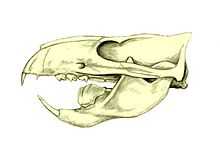Allotheria
| Allotheria Temporal range: Late Triassic-Miocene, 216.5–17.5Ma | |
|---|---|
 | |
| Skull of Ptilodus | |
| Scientific classification | |
| Kingdom: | Animalia |
| Phylum: | Chordata |
| Class: | Mammalia |
| Subclass: | Theriiformes |
| Infraclass: | †Allotheria Marsh, 1880 |
| Subgroups | |
| |
Allotheria (meaning "other beasts", from the Greek αλλός, allos-other and θήριον, therion-wild animal) is an extinct branch of successful Mesozoic mammals. The most important characteristic was the presence of lower molariform teeth equipped with two longitudinal rows of cusps.[1] Allotheria includes Multituberculata, Gondwanatheria,[2][3][4][5] and probably Haramiyida,[6]
Allotheres also had a narrow pelvis, indicating that they gave birth to tiny helpless young like marsupials do.
Interpretations
When he first identified Allotheria in 1880, Othniel Marsh regarded this group as an order within Marsupialia. But in 1997, McKenna and Bell classified Allotheria as an infraclass.
In Popular Culture
The song "Mammal" by They Might Be Giants includes a reference to this extinct group as "dead Uncle Allotheria".
References
- ↑ Butler, P.M. (2000). "Review of the early allotherian mammals". Acta Palaeontologica Polonica 45 (4): 317–342.
- ↑ Krause, D. W.; Prasad, G. V. R.; von Koenigswald, W.; Sahni, A.; Grine, F. E. (1997). "Cosmopolitanism among Gondwanan Late Cretaceous mammals" (PDF). Nature 390 (6659): 504–507. Bibcode:1997Natur.390..504K. doi:10.1038/37343.
- ↑ Krause, David W.; Hoffmann, Simone; Wible, John R.; Kirk, E. Christopher; Schultz, Julia A.; von Koenigswald, Wighart; Groenke, Joseph R.; Rossie, James B. (2014-11-05). O'Connor, Patrick M., Seiffert, Erik R., Dumont, Elizabeth R., Holloway, Waymon L., Rogers, Raymond R., Rahantarisoa, Lydia J., Kemp, Addison D., Andriamialison, Haingoson. "First cranial remains of a gondwanatherian mammal reveal remarkable mosaicism". Nature (Nature Publishing Group, a division of Macmillan Publishers Limited). online. doi:10.1038/nature13922. ISSN 1476-4687.
- ↑ Drake, Nadia (November 5, 2014). "Fossil From Dinosaur Era Reveals Big Mammal With Super Senses". nationalgeographic.com. National Geographic Society. Retrieved November 5, 2014.
- ↑ Wilford, John Noble (November 5, 2014). "Fossil’s Unusual Size and Location Offer Clues in Evolution of Mammals". New York Times. Retrieved November 6, 2014.
- ↑ Luo, Z.-X.; Kielan-Jaworowska, Z.; Cifelli, R.L. (2002). "In quest for a phylogeny of Mesozoic mammals". Acta Palaeontologica Polonica 47 (1): 1–78.
Further reading
Zofia Kielan-Jaworowska, Richard L. Cifelli, and Zhe-Xi Luo, Mammals from the Age of Dinosaurs: Origins, Evolution, and Structure (New York: Columbia University Press, 2004), 249.